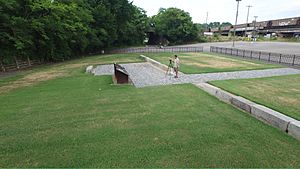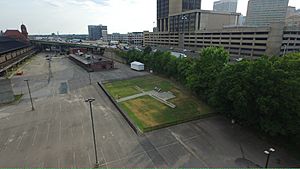Lumpkin's Jail facts for kids
Lumpkin's Jail was a place in Richmond, Virginia, where enslaved people were held. It was also known as "the Devil's half acre." This facility was very close to the state capitol building. From the 1830s until the end of the American Civil War, many businesses in Richmond bought and sold enslaved people.
Robert Lumpkin was the last and most well-known owner of this jail. He bought and sold enslaved people across the Southern United States for over twenty years. Lumpkin's Jail became the largest place in Richmond for holding enslaved people.
Contents
History of Lumpkin's Jail
Robert Lumpkin bought the land for the jail on November 27, 1844. He paid about six thousand dollars for three lots on Wall Street in an area called Shockoe Bottom. This area was named after a nearby stream, Shockoe Creek.
Even though it was named after Lumpkin, the jail was already there. It had two owners before him. Robert Lumpkin became known as the biggest slave trader in Richmond. He was known for being very harsh. Four other lots on Wall Street also had slave jails. This whole area was often called Lumpkin's Alley.
The Lumpkin's Jail complex had four separate buildings. These included Lumpkin's home, a guest house, a kitchen/bar, and the "slave pen" itself. The slave pen was a two-story brick building, about forty feet long.
The main jail area was on the bottom floor. It temporarily held men, women, and children. These people were waiting to be sold to plantation owners or other slave traders. The jail had barred windows and high fences. Its chained gates opened onto the rough streets.
Sometimes, the jail was so full that people were crammed together. They often lacked toilets and fresh air. Enslaved people at the jail sometimes died from sickness or hunger. They also suffered from harsh treatment.
Nearby, there was a market with access to canals and railroads. This market was used for selling enslaved people. Auctions also took place in nearby hotels. Before being sold, enslaved people were cleaned, fed, and dressed up. After the auction, they were forced onto boats or trains to their next destination.
Robert Lumpkin's Life
Robert Lumpkin was a complex person. He was a tough slave trader, but also a family man. He eventually married Mary, an enslaved woman he had bought. They had five children together.
Lumpkin made sure his children received the best care and education. He even sent two of his daughters to a finishing school. Before the Civil War ended, he sent his wife and children to Pennsylvania. This was to protect them from being sold back into slavery if he got into debt.
When Robert Lumpkin died in late 1866, he left all his property to Mary. By then, she was legally allowed to own it.
After the War
In April 1865, the Union Army took control of Richmond. All enslaved people were set free. In 1867, Mary Lumpkin sold the land. She sold it to Nathaniel Colver, a Baptist minister. He wanted to start a seminary just for Black students.
The Colver Institute was built on the site. It later became the Richmond Theological Seminary. Eventually, it became part of Virginia Union University. The land once called "the Devil's half acre" became known as "God's half acre."
Work began to tear down Lumpkin's jail on March 10, 1888. A company called Richmond Iron Works was later built over the old foundation. Today, the area is covered by the Interstate 95 highway and a parking lot for university students.
In the mid-2000s, archaeologists started digging at the site. They dug fourteen feet deep before finding the jailhouse foundation. The ground was always wet from the nearby Shockoe Creek. This helped to preserve things that would normally decay. Archaeologists found items like clothes, shoes, toys, and books. However, they did not find whipping rings or iron bars.
Famous Inmates
Over the twenty years Lumpkin's Jail was open, thousands of enslaved people passed through it. The most famous person held there was Anthony Burns. He had escaped slavery in Virginia. But he was arrested in Boston and put on trial. This happened under the Fugitive Slave Law.
Many people tried to get Anthony Burns released. But he was sent back to Lumpkin's Jail. He was held there for four more months. Finally, people who wanted to end slavery raised enough money to buy his freedom. Once he was free, he went back North and became a pastor. Sadly, he died soon after, at the age of 28.
Images for kids




